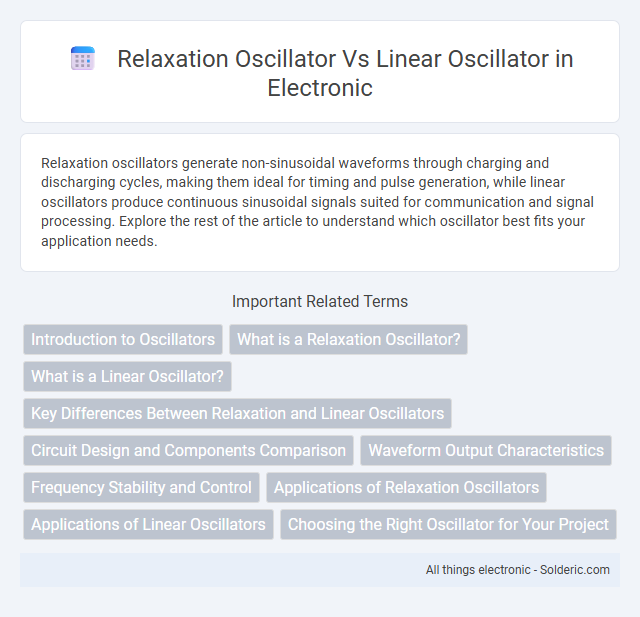Relaxation oscillators generate non-sinusoidal waveforms through charging and discharging cycles, making them ideal for timing and pulse generation, while linear oscillators produce continuous sinusoidal signals suited for communication and signal processing. Explore the rest of the article to understand which oscillator best fits your application needs.
Comparison Table
| Feature | Relaxation Oscillator | Linear Oscillator |
|---|---|---|
| Oscillation Type | Non-sinusoidal, typically square or sawtooth waves | Sinusoidal waveforms |
| Frequency Determination | Set by charging and discharging time of a capacitor | Determined by resonant frequency of LC or RC network |
| Waveform Stability | Less stable, frequency varies with supply voltage and component values | Highly stable with precise frequency control |
| Complexity | Simple circuitry, few components | More complex, requires tuned components |
| Applications | Timing circuits, flashing lights, alarms | Radio frequency generation, signal processing |
| Power Consumption | Generally lower power for low-frequency applications | Can be higher, especially at high frequencies |
Introduction to Oscillators
Oscillators generate periodic signals critical for clocks, radios, and signal processing; relaxation oscillators offer non-sinusoidal waveforms through charging and discharging components, while linear oscillators produce sinusoidal outputs using feedback amplifiers and resonant circuits. Your choice depends on the application requirements such as frequency stability, waveform shape, and complexity. Relaxation oscillators excel in simplicity and low-frequency applications, whereas linear oscillators are preferred for high-frequency, precise signal generation.
What is a Relaxation Oscillator?
A relaxation oscillator is an electronic circuit that produces a non-sinusoidal waveform, typically a square or sawtooth wave, by charging and discharging a capacitor through a nonlinear element such as a resistor or transistor. Unlike linear oscillators, which generate smooth sinusoidal signals using resonant circuits, relaxation oscillators rely on the periodic switching of circuit states to create their oscillations. Your applications may benefit from a relaxation oscillator when a simple, low-frequency waveform with rapid transitions is required, such as in timing circuits or pulse generation.
What is a Linear Oscillator?
A linear oscillator is an electronic circuit that generates a continuous, sinusoidal waveform by using linear components such as capacitors, inductors, and amplifiers operating within their linear range. It relies on positive feedback with a specific phase shift to sustain oscillations at a stable resonant frequency determined by its LC or RC network. Your applications in communications, signal processing, and instrumentation often depend on the precise and low-distortion output signals provided by linear oscillators.
Key Differences Between Relaxation and Linear Oscillators
Relaxation oscillators generate non-sinusoidal waveforms like square or sawtooth waves through periodic charging and discharging of capacitors, while linear oscillators produce continuous sinusoidal signals using linear reactive components such as inductors and capacitors. Relaxation oscillators operate on nonlinear hysteresis behavior, resulting in abrupt switching actions and variable frequencies, whereas linear oscillators rely on feedback networks to maintain stable frequency and amplitude. Key differences include waveform shape, frequency stability, and circuit complexity, with relaxation oscillators favored for timing and pulse generation and linear oscillators preferred in RF and audio signal applications.
Circuit Design and Components Comparison
Relaxation oscillators use nonlinear components like unijunction transistors or operational amplifiers combined with resistors and capacitors to generate periodic waveforms through charge and discharge cycles, resulting in a simple, low-frequency output. Linear oscillators incorporate frequency-selective networks such as LC circuits or crystal resonators, often using transistors or op-amps, to produce stable, sinusoidal signals with higher frequency precision. The circuit design of relaxation oscillators emphasizes simplicity and ease of implementation, while linear oscillators focus on maintaining frequency stability and low distortion through more complex feedback and filtering components.
Waveform Output Characteristics
Relaxation oscillators generate non-sinusoidal waveforms such as square, sawtooth, or triangular waves, characterized by sharp transitions and rapid charge-discharge cycles. Linear oscillators, on the other hand, produce smooth sinusoidal waveforms with stable amplitude and frequency, suitable for applications requiring minimal harmonic distortion. Your choice depends on whether you need simple timing signals from relaxation oscillators or high-fidelity sine waves from linear oscillators.
Frequency Stability and Control
Relaxation oscillators exhibit lower frequency stability due to their reliance on charging and discharging cycles of capacitors, which are sensitive to variations in temperature and component tolerances, resulting in less precise frequency control. Linear oscillators, such as LC or crystal oscillators, provide superior frequency stability by utilizing resonant circuits with high Q-factors, ensuring minimal frequency drift over time and environmental changes. For your design needs demanding precise frequency control, linear oscillators offer a more reliable solution compared to the inherently less stable relaxation oscillators.
Applications of Relaxation Oscillators
Relaxation oscillators find widespread applications in generating low-frequency square waves and timing signals in devices such as flashing lights, tone generators, and pulse-width modulation circuits. Their ability to produce non-sinusoidal waveforms makes them ideal for simple timing applications and pulse generation in digital circuits. You can commonly find relaxation oscillators employed in alarms, blinking LEDs, and oscillator circuits for function generators.
Applications of Linear Oscillators
Linear oscillators are essential in applications requiring stable, low-distortion sinusoidal signals such as radio frequency (RF) communication, signal generators, and phase-locked loops (PLLs). Their precise frequency control and low phase noise make them ideal for medical devices, audio equipment, and instrumentation where waveform purity is critical. Your systems will benefit from linear oscillators in scenarios demanding continuous, harmonic oscillations with minimal signal degradation.
Choosing the Right Oscillator for Your Project
Choosing the right oscillator for your project depends on the desired waveform and frequency stability. Relaxation oscillators generate non-sinusoidal waveforms like square or sawtooth signals with simple circuitry, ideal for timing and flashing applications. Linear oscillators produce stable sinusoidal waveforms suited for communication and precision signal processing where frequency accuracy is critical.
relaxation oscillator vs linear oscillator Infographic

 solderic.com
solderic.com